
Columban Response
In 1932, the Yangste and Han rivers overflowed and flooded vast areas in China. The members of the Missionary Society of St. Columban in Hanyang, China, together with the others, tried to come to the aid of the thousands of people in Hanyang affected by the Great Flood.
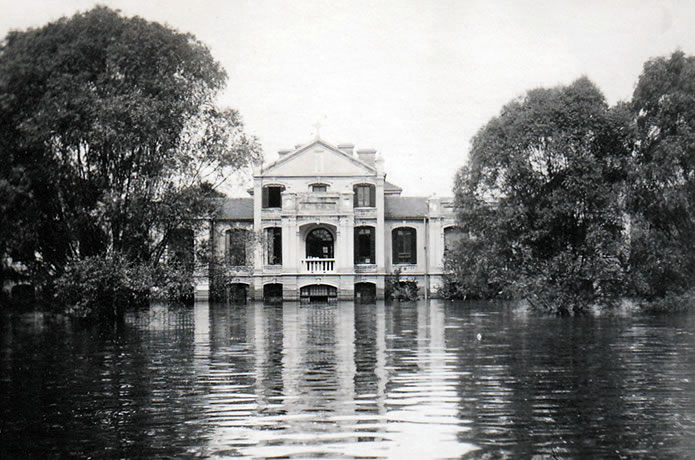
The relief work under the auspices of Hanyang Vicariate was carried out by different groups within the vicariate working in collaboration. These groups were the Missionary Society of St. Columban, the Columban Sisters, the Loretto Sisters, the Virgins of St. Mary, and lay helpers. Bishop Galvin was the main coordinator of the work.
The Yangtse River
The Yangtse rises in Qinghai province, and flows down eastwards for a distance of 6,300 kilometers, through eight provinces until it reaches the Yellow Sea. The Yangtse has been a source of flooding from time immemorial. This is because of the volume of water it contains and attracts.
There are other factors besides the flow of the river and the number of tributaries which flow into it which explain the propensity of the Yangtse to overflow. One is the very quantity of rain it receives. With the summer heat the snow glaciers on the mountains of western China melt and flow into the Yangtse.
The Yangtse Valley and Its Cities
The Yangtse Valley is the drainage area of the Yangtse River, and includes many important provinces of central China. It has an area of 650,000 square miles and at the beginning of the 20th century had a population of between 170 and 180 million. The most important cities of the middle section, located where the Han River meets the Yangtse, were Hankow, Wuchang and Hanyang.
Political Context of the Flood and Relief Effort
The Great Flood of 1931 took place against the background of significant historical developments in China which were, at the same time, a cause of added trauma for the Columbans. Cooperation between the Nationalist and Communist parties had recently broken down, and the Communists were extending their control over large sections of the Columban vicariate just as they were over other areas. Communist bandits had killed great numbers of people. They attacked, robbed, and destroyed many parishes and took several Columban priests hostage. Two priests, Fr. Patrick Laffan and Fr. James Linehan were taken prisoner on April 23, 1930, and held for ransom. They were released on December 1 of the same year after a ransom was paid.
Just at the same time as the flood was at its worst, and Bishop Galvin was concerned about the refugees in Hanyang, and was fully occupied in trying to relieve their suffering, he was burdened by a further anxiety. Word came that Fr. Hugh Sands had been captured by Communist bandits on August 16, 1931, and was being held for ransom. This required constant efforts on Bishop Galvin's part, first to discover the whereabouts of Fr. Sands and then to try to bring about his release. When a ransom was eventually agreed with the Communists and paid on November 1, 1931, Fr. Sands gave his chance of freedom to an elderly Italian Franciscan priest, Fr. Lazeri, who was being held for ransom with him. Fr. Sands didn't obtain his release until May, 1932.
Central China Flood, 1931: Overall Extension
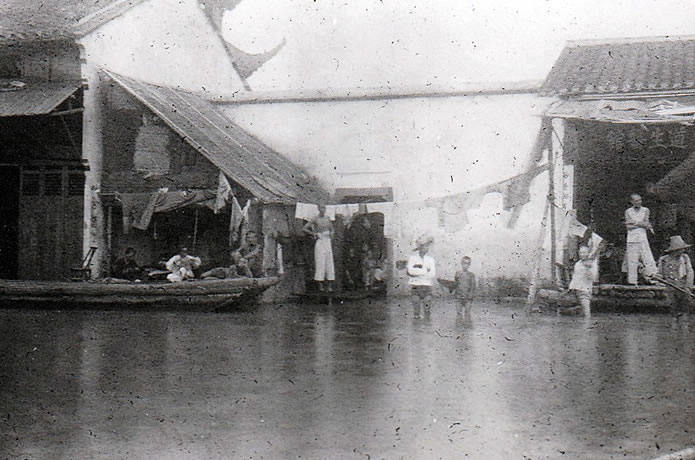
The Central China Flood of 1931 extended over the whole of the Yangtse Valley and inundated 70,000 square miles and 8.5 million acres of farmland. According to Jonathan Spence (The Search for Modern China, p.434) it flooded an area the size of New York state. Nanjing, the capital of China at the time, was under water for six weeks.
The flood affected between 80 and 100 million people, thirty million of whom were made homeless. In the Wuhan Valley alone 250,000 people died by drowning, disease or starvation.
Flooding in Wuhan
Early in the morning of August 1, the dyke protecting Hankow broke and the water from the Yangtse swept into the city drowning 5,000 people almost immediately. The water also reached Hanyang, which, up until then, had remained relatively dry. It didn't come with the same rush as in Hankow, but gradually flooded streets and houses. Some streets in Hankow and Hanyang were under nine feet of water, others under twenty feet. In a letter of August 20, probably from Bishop Galvin, we read how "houses, factories, hotels have collapsed burying hundreds of people in the debris beneath the waters."
Wuhan remained awash for four months, and fields nearby, not protected by dykes, were under thirty feet of water. Writing in October, Bishop Galvin described the situation: "From the hill at the rear of the Mission, the whole country as far as the eye can see is one vast sea of water."
Flooding in Columban Headquarters
Among the buildings affected by the flooding in Hanyang were the Columban headquarters. Already at the end of July Bishop Galvin informed Fr. Michael O' Dwyer, the Columban Superior General stationed in Ireland, that there were eight feet of water in the compound of the headquarters. At the gate the water was lapping at the top of the compound wall, part of which had collapsed. Then the waters invaded the main house and rose during August from eight feet to fifteen feet. They covered the ground floor and crept up to the landing at the top of the stairs. They didn't reach the top storey of the house which could still be used. People entered and left here in small boats, going in through a window.
A storehouse separate from the main building, containing foodstuffs, mattresses, and other household goods was also flooded. Good swimmers among the Columban seminarians, who had taken refuge in the headquarters, used their skills to save undamaged goods from the ground floor of the headquarters and from the storeroom. Swimming from the storeroom, they had boxes in tow. In this work they were helped by a few of the priests who were also good swimmers, namely Frs. Chang, Joseph Seng and Fergus Murphy.
Location of the Refugees
The flood brought a huge influx of refugees into the area. Bishop Galvin wrote in a letter of August 31 that there were already 300,000 to 500,000 refugees in Wuhan, and that soldiers had been posted along the banks of the Han River to prevent any more from entering. Most of the refugees were located on hills in the three cities making up Wuhan, namely, Hankow, Wuchang and Hanyang. On the Black Hill in Hanyang there were 60,000. From early on Bishop Galvin realized that many of the refugees would still be there during the winter and feared how the cold of the winter would affect them. Many of the refugees were Catholics from parishes all over the Vicariate.
The easing of the flooding didn't ease the flow of refugees. Many still kept coming to escape the depredations of Communist bandits in the areas where they lived.
In a letter of November 1, 1931, Bishop Galvin described how all these locations were dotted with makeshift shelters made from matting. Scarcely a square foot of ground was unoccupied. A family lived in each of these flimsy shelters, which provided very inadequate protection against the burning heat of summer (when the rain stopped) and equally harsh cold and rain of winter. In these areas there were no sanitary facilities at all. I will leave it to Bishop Galvin himself to give an idea of the conditions:
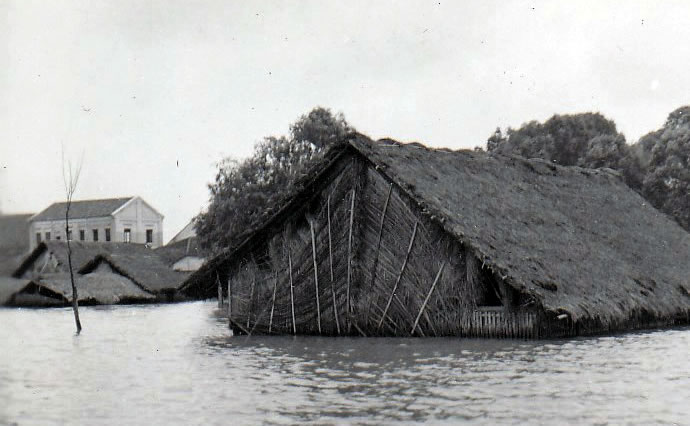
"I simply cannot describe to you the scenes of unspeakable squalor, sickness, and desolation, that everywhere met our eyes as, day by day, we walked through those different camps. On all sides heartbroken people were quietly dying of starvation; all were undernourished and dying from exposure and in a short time malaria, dysentery, typhoid, cholera and smallpox spread like a prairie fire from camp to camp and took their terrible toll. The infants in arms and the children under four years of age were, of course, the first to succumb."
Such was the misery and deprivation on the Black Hill that the people were often driven to desperation. Another writer summed up his reaction to the whole scene, "No words could describe the pitiful desolation of it all."
Bishop Galvin set aside five buildings belonging to the Vicariate as shelters for the refugees. One was the new convent which has just been built for twelve Columban Sisters. It was now made to accommodate over four hundred refugees. Another was the Catechumenate, directed by the Columban Sisters. One hundred and seventy refugees were housed there. A third was in the compound of the Loretto Sisters, where two hundred and fifty refugees were housed. The fourth building was composed of several houses which Bishop Galvin bought to accommodate young girls who had been living on the hillsides. A fifth was a house which had been bought to give shelter to the most wretched refugees from the Black Hill. Ninety people found refuge there.
Relief Work
Relief work fell into different categories. One was the distribution of food. Another was the distribution of medicines and the giving of injections. In some situations the missionaries gave money to the refugees. A very significant aspect of the missionaries' work was religious, administering the Sacrament of the Sick, and perhaps, more often, the Sacrament of Baptism, especially to dying babies. The priests also administered the Sacrament of Reconciliation. A final service was the burial of the dead.
Relief Work on the Hills
Bishop Galvin organized the priests, Sisters, and Virgins, into different teams. Each priest with his team was assigned a refugee camp. Each team went out early every morning to carry out the relief work and returned late in the evening. At midday the members survived on a sandwich. Each morning each team collected a basket of medicines, with sections for different kinds of medicines, from the Columban Sisters' dispensary. On their return in the evening they left the basket at the dispensary to be refilled with medicines for the next day. The members of the teams had received a basic training in the diagnosis of illnesses and administration of the appropriate medicine from three of the helpers who had been trained professionally. One was Fr. Frank McDonald who had qualified as a doctor in the University of Glasgow. Another was Columban Sister Mary Patrick, a trained nurse, who had also done an extended course in tropical medicines at the School of Tropical Medicines in London. A third was Sister Mary Ignatius who had trained as a nurse in St. Vincent's Hospital, Dublin. Later, the professionally trained staff was augmented by the arrival of a Chinese doctor, Dr. Chen.
Because of drinking the polluted water which was all around them there was a grave risk that refugees would contract cholera. With the assistance of Dr. Chen the teams began to inoculate as many as 900 people a day against cholera, typhoid, and paratyphoid. By doing so they were able to save thousands of lives.
In his History of the Diocese of Hanyang (in typescript) Fr. Abraham Shackleton gives us a vignette of the activity of the priests on the hills. He quotes a young missionary:
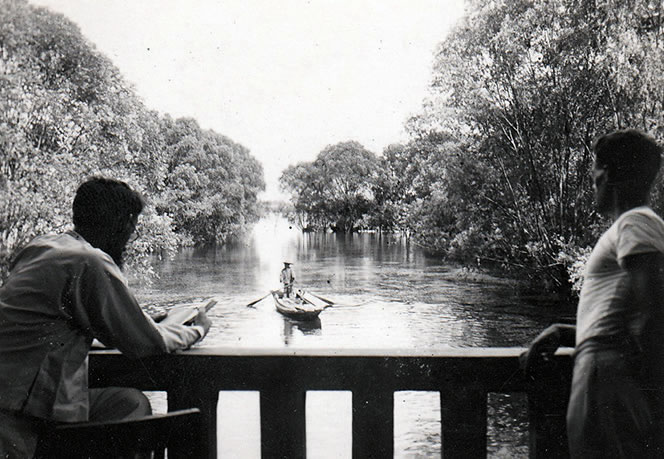
under 12 feet of water
"Father Aedan (McGrath) and I separated for a moment. When I next came upon him he was treating the most pitiful case I have ever witnessed or hope to witness again. An old Chinese woman lay helpless in her mat shed in the burning heat of August. The place was literally black with flies of the worm generating blue headed type. From head to foot she was covered with worms. Her condition does not bear description. Fr. Aedan was bending over her brushing the worms away. At that moment a pagan came to tell me that his daughter was dying. He took me a long way off but we just arrived in time. I baptized her immediately and in less than five minutes she was dead.
When I returned half an hour later Fr. Aedan, now joined by Fr. Fisher, was still at his task. In the meantime, the two priests had called some men, and giving them a ticket of admission, had the old lady taken to the hospital. There she received every attention and died some days afterwards, fortified by the rites of the Church. We returned that evening with our hearts as light as our baskets. We had attended over two hundred people and had fifty baptisms to our credit.
Other Forms of Relief
In addition to providing food and medical care for the refugees, Bishop Galvin on occasion, provided financial aid. Large numbers of people from Mienyang County took refuge on the Black Hill in Hanyang. Many were Catholics, and Bishop Galvin had a special concern for them. Fr. Timothy Leahy who was the Parish Priest of Tsandankow Parish described the situation in an article in the Far East magazine in 1949:
"His (Bishop Galvin's) first concern was for the Catholics …. From the parish of Tsandankow alone, during the first few weeks of the flood, some 500 of them quietly died of hunger. The bishop decided to save the remainder from extinction, and so, for Tsandankow and the neighbouring parishes he allocated thirty five Chinese cents per person per week. It was, by necessity, a very small sum, yet to destitute people it represented the difference between survival and starvation."
Spiritual Help
Besides their activities at the material level, the priests and Sisters gave spiritual assistance. They heard confessions and gave the Last Rites. In reviewing their work the priests and Sisters were always deeply satisfied at the number of children they had baptized just before death. In a letter to Fr. Michael McCarthy in November 1931, Fr. William McGoldrick anticipated the difficulty of feeding so many refugees during the winter, but he added:
Already we have been well paid in advance. Four thousand babies baptized and sent to heaven since June, this is almost the grandest harvest we have reaped since coming to China.
Sheltering Refugees in Buildings
In addition to the work on the hills, the Vicariate offered shelter to around one thousand people in buildings belonging to it. One of these was the catechumenate normally directed by the Columban Sisters. Here one hundred and seventy women and children were accommodated and fed. Even more found refuge in the new convent being erected for the Columban Sisters. Bishop Galvin asked the Sisters for the use of the convent, and they readily agreed. Eventually 439 refugees were accommodated there, "living like peas in a pod" in a house which was designed for twelve people. In a letter of December to Fr. Hayes in Australia Bishop Galvin gave an idea of conditions in the convent:
The refugees had brought with them malaria, dysentery, typhoid and smallpox. In every room and corridor the sick and dying lay huddled together on the floor; the building swarmed with flies and the odor of foul air and sickness was overpowering.
Under the direction of Fr. Francis McDonald, a doctor, Sisters Patrick and Dolores were responsible for looking after the sick. Bishop Galvin wondered at their "quiet thoroughness and efficiency." Almost half of the people who lived in the convent died, four or five each day. The bodies were carried out for burial in the early hours of the morning accompanied by crying relatives. Every day for two months five carpenters were engaged in making coffins in a corner of the compound. Bishop Galvin wrote: "I could never pass this little shed where they worked without a shudder."
Dispensary
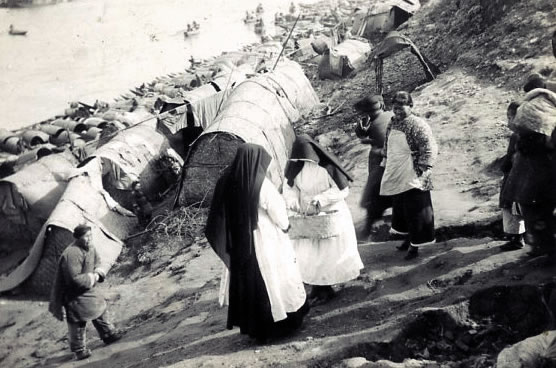
In addition to the buildings mentioned above where refugees lived and were given medical attention, the Columban Sisters had a dispensary where refugees were attended on an out-patient basis. It had been opened on October 3, 1930, and during the flood attended around 150 patients each day. During the cholera epidemic it was thronged with people, many of whom also received instruction in the faith and were baptized.
The Effect of the Flood on Priests and Sisters
Bishop Galvin had to pay a heavy price emotionally for his involvement in the relief effort. He was deeply moved by the plight of the refugees. "It is dreadful. I have never experienced anything like it in my whole life. Poor Hanyang." This was written in late August 1931, when the flood was at its height; but Galvin was already dreading the suffering which winter would bring: "I tremble to think of the winter to come; the crops are ruined, there will be no foodstuffs and famine will complete the ruin that the floods have begun." All around him people were dying of starvation. "Poverty is hard, but hunger is terrible," he commented. And this hunger made the desperate people cling on to Bishop Galvin in the hope of getting relief, so that he sometimes feared even to go out among them.
To add to his suffering was the loss of Fr. Tom Quinlan who was transferred to Nancheng, Jiangxi Province, in July (through he was allowed to postpone his departure in order to continue with his relief work). "Tom is a terrible loss," lamented Bishop Galvin, "I think I will never feel the loss of anyone who may go from here as I feel Tom's."
During the flood several priests were sick and in the hospital. It is hard to imagine that the stress of living in the midst of such flooding, surrounded by poverty, sickness and death didn't affect their health. Fr. James Loughran, Fr. Owen McGrath and Fr. Tom O'Rourke were in the hospital in October 1931. Fr. Francis Murray and Fr. John Cowhig had gone to Shanghai for operations. Fr. Bob Galvin returned to Ireland in August.
Though the priests and Sisters were active among the cholera victims, only one of them contracted cholera. That was Columban Sister Ignatius, who succumbed on November 1. Eventually, she reached the hospital, where Sr. Patrick broke down in tears after the ordeal of the trip. Sr. Ignatius eventually recovered.
Effect of the Flood on Evangelization
Reflecting on the experience of the flood, Fr. Timothy Leahy commented in an article in the Far East of June 1949:
"The people fled from their homes to the Hanyang district where our priests and Sisters took care of them. During our daily visitation among them we were able, in six months, to get more intimately acquainted with them than we would in several years of ordinary mission work.
This new familiarity with the priests and Sisters plus their gratitude for what these had done for them led many people from the villages of the Vicariate to take an interest in the Church after they had returned home. Bishop Galvin expressed it like this: "This work of ours has endeared our priests and Sisters not merely to the Catholics but to numberless pagans as well." As a result many pagans began to have an interest in the Church. As Fr. McGoldrick wrote:
Villages which had never known a Christian inhabitant came to ask the priest to send them a catechist. When a complete list was drawn up it was found that no fewer than 60,000 people were seeking admission into the Church, and in two years after the flood, 10,000 people were received into the Church.
Source of Money and Funds for the Relief Effort
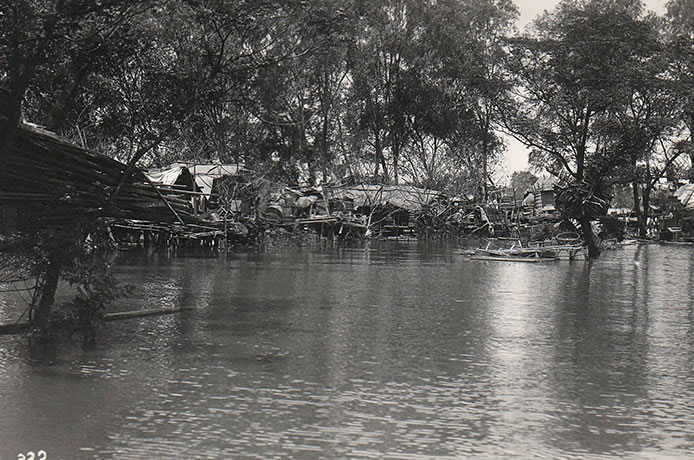
Bishop Galvin made various appeals which he was convinced would meet with a good response. Meantime, he used what he referred to as old famine money (presumably left over from previous emergencies). The Superior General, Fr. Dwyer, said he would send three hundred pounds if it were necessary or useful and would be ready to contribute more later. The Loretto Sisters used all the profits from the embroidery school to buy food and clothes for the refugees. Bishop Galvin had previously received a thousand pounds from the Bishop of Cork which he hoped to put into some project that the bishop would be pleased with, but was prepared to use it for famine relief.
Even though the flooding had subsided it became clear as winter 1931 approached that there would still be a lot of refugees on the hills and in the parish buildings. At the same time the money which had been contributed for relief was running out. Fr. McGoldrick, reflected: "As usual the mission was short of funds. Still, every other consideration had to go and every available cent was put into the relief....How the money came seems almost a miracle—though, of course, most of it came from America."
End of the Flood and Flood Relief
In a letter of September 9, Bishop Galvin said that there was still six feet of water in the Columban compound. In general, the floods began to recede in the second half of September. It was a slow process and continued into October. Fr. Seamus O'Rourke gives a vivid picture of how it was experienced in the Columban compound. On October 25 he wrote, "We were using a boat in the compound on this day last week and it is now dry—the boys are hurling (playing a ball game) on it." Fr. O'Rourke was already planning the necessary repairs to the headquarters. However, it took much longer before all the refugees had left. In a letter of mid-November, Fr. McGoldrick quoted Bishop Galvin as saying, "There will be thousands of flood refugees to be fed by the mission right through the winter." Indeed, new refugees kept arriving, fleeing from the Communists. Realizing how difficult it would be for many of the refugees to return home, the Columban Sisters decided to let them stay on in their new convent until the end of winter.
In January 1932, the Sisters themselves had to take refuge in Hankow because of the threat of the imminent arrival of Communists in Hanyang. In early February, when the threat had passed and the Sisters had returned to Hanyang, Bishop Galvin decided it was time to encourage the refugees to leave. On February 20, they began to leave the catechumenate and the new convent, though some homeless widows were allowed to stay on, and continued to be fed. There were still many people left on the hills, and some people considered them a menace to Hanyang because the relief program had come to an end, and these people were starving. The Sisters continued to visit these refugees and to administer the Sacrament of Baptism to both dying children and adults.
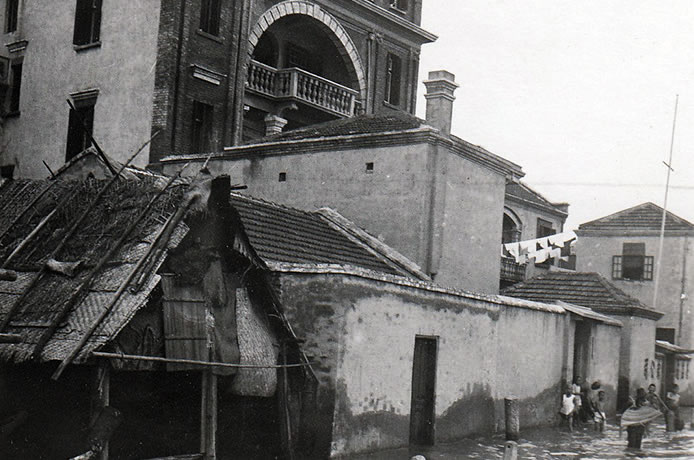
evacuated mat houses
A sign that normality was returning was that by June 1932, stalls with fresh food and vegetables were beginning to appear again in the streets. Another sign of returning normality was the blessing by Bishop Galvin of the Columban Sisters new convent on October 1, 1932. Until a few months previously over four hundred refugees had found shelter there. After the blessing ceremony, Bishop Galvin offered Mass in the convent chapel.
In the autumn of 1932, 200,000 refugees returned to Mienyang. By this time the relief program had come to an end, as there were no more goods nor money to distribute.
Conclusion
We can well imagine that when the missionaries came to China in 1920, they were filled with idealism and expected to be faced with many challenges. Some years before they arrived there was a major political revolution when the imperial system which had lasted for several thousand years came to an end to be replaced by a presidential system. However, they couldn't have foreseen that the country would be embroiled in an ongoing conflict between competing warlords or a bitter struggle between the Nationalist Party and the newly formed Communist Party. All of these conflicts brought an element of danger into the lives of the missionaries. They led to the deaths of some of the missionaries and to several of them being held hostage for the payment of a ransom.
During their first years in China some at least of the priests had to deal with floods in their local areas. However, none of them could have imagined the apocalyptic dimensions of the flooding of 1931 which covered the whole of the central Yangste valley.
Bishop Galvin believed that no other missionary Society had to meet such an enormous challenge in its earliest years. I think we can agree with him in his admiration for the way the priests and Sisters responded to this challenge, and conclude that they met the challenge admirably, inspired by their love for God, and their devotion to the people.
Columban Fr. Joe Houston lives and works in China.


 The Columbans are a society of missionaries, including priests and lay people, who minister to people of various cultures as a way of witnessing to the universal love of God.
The Columbans are a society of missionaries, including priests and lay people, who minister to people of various cultures as a way of witnessing to the universal love of God.